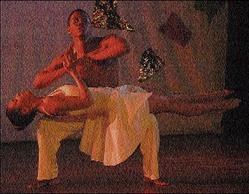Michael Reckord, Gleaner Writer

Dancers perform 'Ways of Love', choreographed by Marlon Simms at Danceworks 2008, A Potpourri The Explosion of Movement' at the Edna Manley School of Dance on Saturday. - Colin Hamilton/Freelance Photographer
It was gala night, and there were servings of jazz, contemporary, folk, Afro-Cuban movement and dancehall for the packed School of Dance Studio Theatre audience, at the Edna Manley College of the Visual and Performing Arts, on Saturday.
With RBTT as its main sponsor and dubbed RBTT'S Danceworks - Potpourri: The Explosion of Movements, this second and third year student production comprises of ten dances. The dances were choreographed by nine choreographers who include lecturers and world renowned Clive Thompson as guest.
Divided into two sections, Danceworks began with an innovative concept. Projected on the plain backdrop were pre-recorded interviews, conducted by three interviewees with choreographers, the director of the School of Dance and three of the dancers. But alas, despite excellent visual, this great concept was marred by poor audio and the late arrivals to the show.
High-quality dances
However, the dances were generally of a high quality. There was clarity in movements, well defined lines and great use of levels and space. The stage was bare. Costumes, appropriately designed, were the brain child of each choreographer, for his or her respective dance.
The dances were aptly titled: Wangi (Marlon Pennant), Sorry Dear and What a Rhythm (Robertha Daley), Weh Every Baddi A Run Goh? (Howard Daly), Body Parts (Lisa Dobson-Wilson), Ways of Love - excerpt (Marlon Simms), Party Vybez (Kimiko Miller), That Blooming Thing, Love (Neila Ebanks), The I Am (Patrick Earle) and Collage (Clive Thompson)
Wangai, a West African dance was the first to grace the stage. The seven dancers under the guidance of choreographer Marlon Simms, seemed a bit nervous at the offset, but came in to their own as the dance progressed. There was use of creative formations, controlled and much focused movements. The power of the drum is central to the people of West Africa as shown in the dance, and by the use of live drumming by the EMC drummers.
No music
Weh Every Baddi A Run Goh?, a modern contemporary dance, was the most innovative of all the dances performed. This avante garde (experimental) dance was created by Howard Daly.
Five dancers/characters dressed in all white seem to be in a hurry. They enter and exit at intervals, at times bumping into each other. Despite falling, the need to hurry is not diminished.
But the most striking part about this dance is the choreographer's decision to not use music; he instead chose the footsteps made by the dancers/characters to create the required sounds. At times, the sounds of footsteps were contrasted with periods of silence.
Fittingly, the second half ended with Party Vybez choreographed by Kimiko Miller (third-year student). Miller used the dancehall genre and 17 dancers to showcase "a real life dancehall session"
The dance was high energy, and performed to a medley of songs from musical artistes such as Beenie Man and Junior Gong. The constant shift in formations adds to the dynamism of the dance.
Dancing Dynamite's Neila Ebanks choreography entitled That Blooming Thing, Love opened the second half of the show. This dance drama shows that love is perennial "through the years love remains ". The dance goes through three stages: 'tots' (toddlers), 'teens' and 'elders'. At each stage, the relationship seems to go through the "break up to make up mode".
Bringing Ebanks' artistry to life were Tashika Tenn and Steven Cornwall (tots), Keisha Amory and Paul Newman (teens), and Catherine Miles and Orlando Barnett (elders).
Another dimension to this dance is the choreographer's decision to have the initial entrance made from the audience, and the flower used to link the three stages.
The show ended with Clive Thompson's Collage, "a reflection on the tapestry of our various styles of movement as handed down by our talking heads of dance".
Collage is divided into two distinct parts: 'The Past', and 'The Present and the Future'. Each part subdivided into short motifs. The dance is a patchwork of different forms such as classical ballet, folk (Kumina) and modern contemporary and jazz. All forms were creatively choreographed and executed accordingly, but Jazzy and Shake took the cake.

